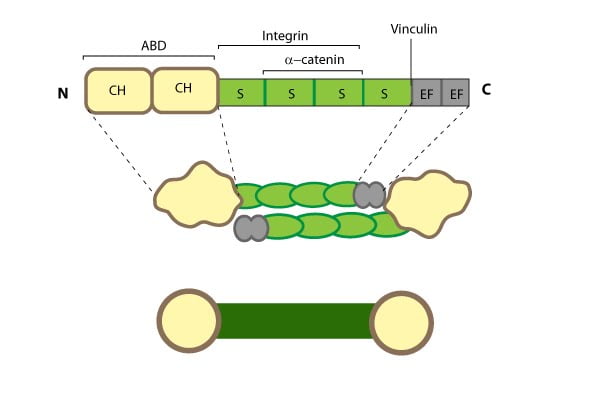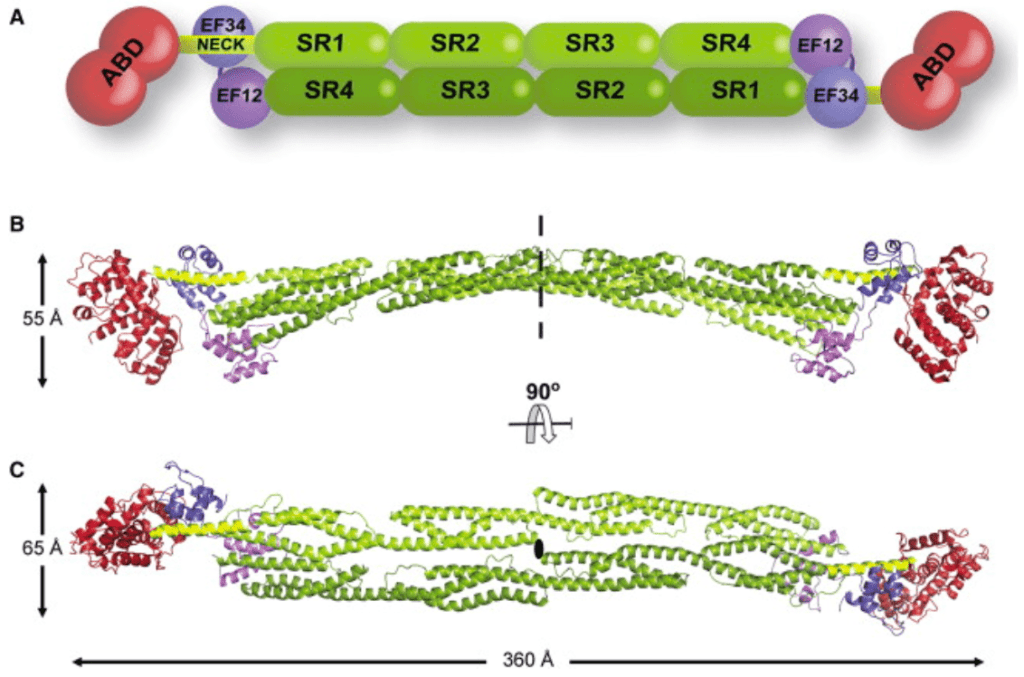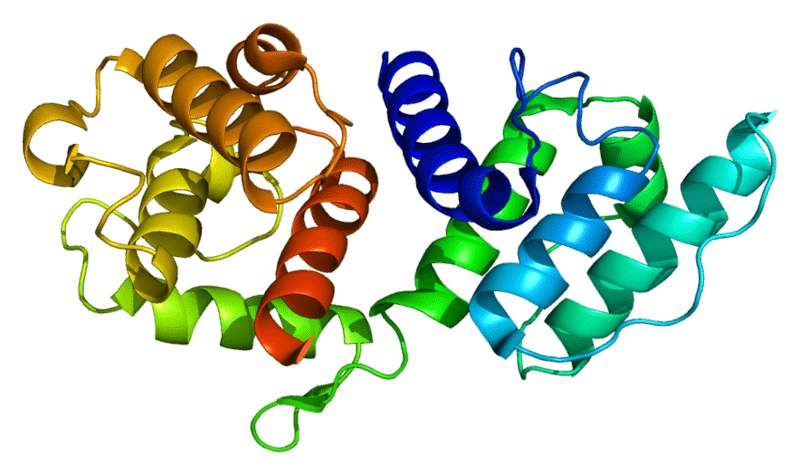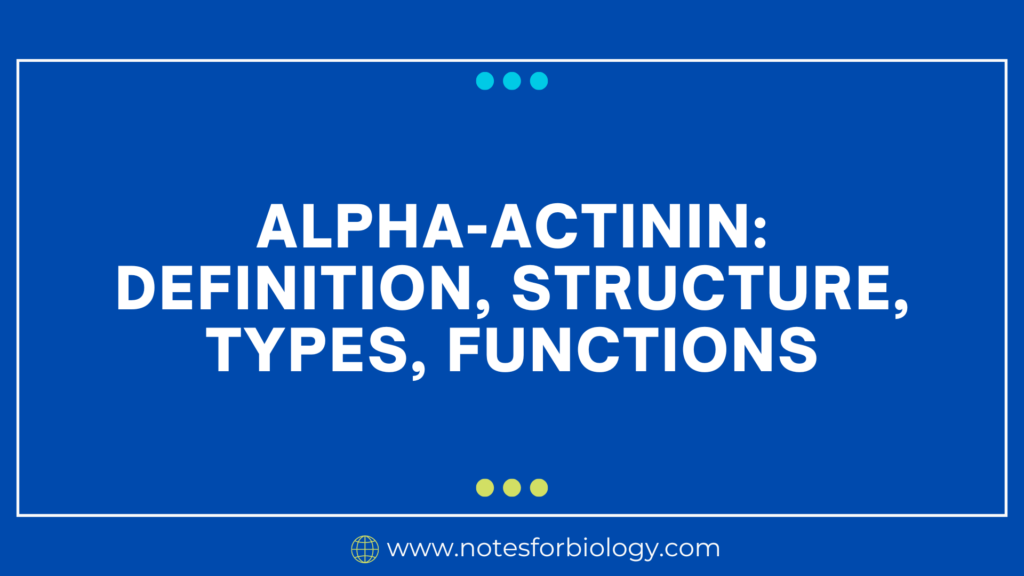Certainly! Let’s delve into the fascinating world of alpha actinin.
Definition of Alpha-Actinin
Definition: It is a protein that binds to actin and is vital to many kinds of cells. It is part of the spectrin superfamily, which includes proteins like spectrin and dystrophin.
Table of Contents
Structure of Alpha-Actinin
Structure: It forms an anti-parallel rod-shaped dimer with one actin-binding domain at each end of the rod. In many cell types and contexts, these dimers bundle actin filaments and support the cytoskeleton’s structural integrity.
The actin-binding protein alpha-actinin lacks the ability to bind G-actin (globular) but can bind F-actin (filamentous).
The anti-parallel homodimer alpha-actinin is essential for the cellular cross-linking of actin filaments. An N-terminal Actin binding domain (ABD), spectrin repeats (SR), and a C-terminal calmodulin-like domain (CaM) are the distinguishing characteristics of all spectrin superfamilies, including alpha-actinin.
- There are two calponin homology (CH) domains in the ABD region.
- The length, pliability, and kind of actin filament cross-links of the actin-binding protein are all determined by the spectrin repeats (SR). The rod domain is made up of the cylinder-shaped SR area, and the functional core rod in the alpha-actinin anti-parallel dimer is made up of four SR and ABD.
- Opposite the ABD at the end of the central rod is the C-terminal CaM domain.

They are widely distributed in both the cytoskeleton of non-muscle cells (calcium sensitive) such neurons and fibroblasts and the cytoskeleton of muscle (calcium insensitive). It is primarily in charge of the cytoskeleton’s structural element, which helps cells attach and arrange actin filaments. They are found in various regions of cells based on the kind of tissue they are in and are members of the spectrin superfamily, which is a wider class of proteins.
It contains two pairs of EF-hand motifs (EF1/2 and EF3/4), which in the binding protein have a regulatory role. Actin filaments can cross-link form bundles when certain actinins bind to calcium, preventing actin from binding at high calcium concentrations in both muscle and non-muscle cells.

Types of Alpha-Actinin
It is discovered that the cytoskeleton activity in both muscle and non-muscle cells is regulated by four different forms of alpha-actin.

- ACTN1: Z-lines bind to actin myofibrils in skeletal muscle cells via this gene, which is encoded. Actin filaments are attached to dense bodies by ACTN1 in smooth muscle cells.
- ACTN2: A protein expressed in smooth and skeletal muscle cells, it is encoded by the human ACTN2 gene and consists of 894 amino acids with a molecular weight of roughly 103.8 kDa. They use phospholipids to mediate the anchoring of filamentous actin fragments to Z-disks.
- ACTN3: Only expressed in type II muscle fibers, the ACTN3 gene (also called the Sprinter gene) on chromosome 11 codes for this protein. They play a role in the elite athlete’s rehabilitation from muscle injuries and improved athletic performance.
- ACTN4: A gene that codes for ACTN4 and is implicated.
Functions of Alpha-Actinin
Their primary role entails the actin filament and other cytoskeleton components’ cross-linking, which influences the cohesion and mechanics of cellular movement. The scaffold functions as a link between the cytoskeleton and signaling pathways, giving actin filaments stability. It is estimated that alpha-actinin interacts with over thirty different cellular components, and certain of its isoforms are known to be involved in nuclear processes.
They are very active in polarized cells, where a large amount of actin polymerization promotes cell adhesion and migration. They are widely distributed in dendritic spines and serve as the main cross-linkers in stress fibers, which promotes neuritic development and focal adhesion. Their interaction causes this protein to be localized to membrane lipids and transmembrane receptors in cellular compartments like plasma membranes.
Frequently Asked Question(FAQ)
What is Alpha-actinin in simple terms ?
It is an actin-binding protein that plays essential roles in various cell types. It is part of the spectrin superfamily, which includes proteins like spectrin and dystrophin.
What is the structure of Alpha-actinin like ?
It forms an anti-parallel rod-shaped dimer with one actin-binding domain at each end of the rod. In many cell types and contexts, these dimers bundle actin filaments and support the cytoskeleton’s structural integrity.
What are the types of Alpha-actinin?
The types of alpha-actinin are ACTN1, ACTN2, ACTN3 and ACTN4.
Related Article

